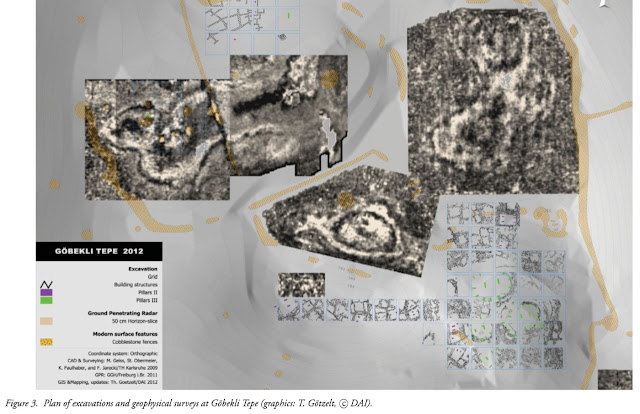Gobekli Tepe is huge!
This is for the benefit of those that haven't yet seen the subsurface radar scan of Gobekli Tepe. The above image is from Deitrich et al., Antiquity vol. 86 (2012), freely available on the internet.
The little portion of Gobekli Tepe so far excavated corresponds to the detailed portion of the map, bottom right, which includes the main circular enclosures A to D. As you can see, even Enclosure D, the oldest and largest enclosure yet uncovered, corresponding to the uppermost green circle is small relative to some of the remaining structures.
The structure right in the middle of the plot looks especially interesting - being nearly twice the diameter of enclosure D. Considering the progression of these structures - they seem to get larger as they get older - perhaps this central enclosure is the 'heart' of Gobekli Tepe, and will reveal a great deal more about its function and purpose.
But some of the other structures remaining in the ground also look to be massive. Quite possibly, we have only scratched the surface of Gobekli Tepe so far, and the main event remains to be excavated.




Are you aware of any current plans to excavate the site further? Has work been paused since Klaus Schmidt's death in 1994? I haven't found any recent information, though it would seem like an archaeological priority even for those who are not testing the zodiac theory.
ReplyDeleteI haven't seen anything new for a few years. My understanding is that they are in no hurry, and are happy to wait for advances in technology to occur that might improve their understanding of any new excavations. Of course, being cynical, it is clearly in their interests to go as slowly as possible - to stretch out the funding for as long as possible.
DeleteHi, thanks for the amazing work. Have you looked at the Easter island statues at all? They all face east I believe but the petroglyphs on the them are interesting. There's a massive painting on a rock which has a lot of detail.
ReplyDeletePerhaps this complex was built at Gobekli Tepe because it is the geographic epicenter of the airburst that destroyed Abu Hureyra? Survivors might have triangulated the spot from their various observer locations, or seen evidence such as radially blasted trees, as in Tunguska.
ReplyDelete